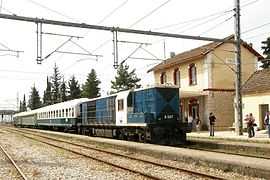Tithorea
| Tithorea Τιθορέα | |
|---|---|
|
Tithorea railway station | |
 Tithorea | |
|
Location within the regional unit  | |
| Coordinates: 38°35′N 22°40′E / 38.583°N 22.667°ECoordinates: 38°35′N 22°40′E / 38.583°N 22.667°E | |
| Country | Greece |
| Administrative region | Central Greece |
| Regional unit | Phthiotis |
| Municipality | Amfikleia-Elateia |
| Population (2011)[1] | |
| • Municipal unit | 3,198 |
| Time zone | EET (UTC+2) |
| • Summer (DST) | EEST (UTC+3) |
| Vehicle registration | ΜΙ |
Tithorea (Greek: Τιθορέα) is a village and a former municipality in Phthiotis, Greece. Since the 2011 reforms of local administration, Tithorea constitutes a municipal unit in the municipality of Amfikleia-Elateia.[2] Population 3,198 (2011).
Geography
The municipal unit consists of the town Kato Tithorea (the seat of the former municipality) and the villages of Agia Marina, Agia Paraskevi, Modi and Tithorea. Liakoura (ancient Lykoreia), the highest summit of Mount Parnassus at a height of 2,457 m,[3] lies in the southernmost part of the municipal unit. The river Cephissus flows in the valley North of the town. Kato Tithorea has a station on the Athens-Thessaloniki railway line.
The village Tithorea is situated at the northern foot of the Parnassus, 5 km southwest of Kato Tithorea. It is a traditional settlement with stone houses. The main sights are the ancient wall and castle, the water mill, the mosaic floor of the chapel of Saint John, the gorge of Kachalas, the churches of Avvas Zosimas, Agiarsali and Saint George, the beautiful forest (a NATURA 2000 area) and the cave of Odysseas Androutsos.
History
Tithorea was named after the ancient Phocian town Tithorea, also referred to as Neon, built on the slopes of Mount Parnassus, on the exact location of the modern village of Tithorea.[4] Before 1926 it was known as Velitsa (Βελίτσα),[5] a Slavic toponym.
The ancient city was built after the destruction of the nearby cities by Xerxes' Persian army in 480 BC. According to Herodotus, inhabitants from ruined cities located on the banks of the Cephissus fled to the foot of the Parnassus around Tithorea.[6] After the Persians left, the Phocians settled around Tithorea where a fortress was built. The city reached its peak in the 3rd century BC, when it minted its own coins.[7][8]
External links
- Municipality of Tithorea (Greek) (English)
References
- ↑ "Detailed census results 2011" (in Greek).
- ↑ Kallikratis law Greece Ministry of Interior (Greek)
- ↑ Oreivatein.com
- ↑ TITHOREA (Velitsa) Phokis, Greece, entry in The Princeton Encyclopedia of Classical Sites.
- ↑ Name changes of settlements in Greece
- ↑ Herodotus, Histories Book VIII
- ↑ Kato Tithorea Gymnasium, History of Tithorea (Greek)
- ↑ Arxaiologia.gr Article from the archeologist Fotis Dasios(Greek)
| ||||||||||||||
